-
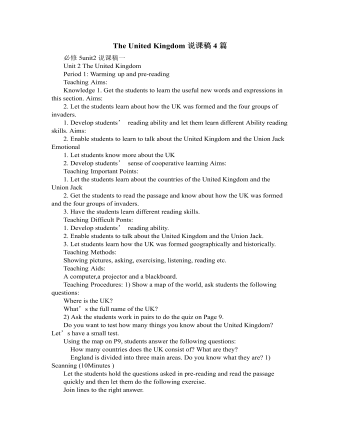
人教版高中英语必修5The United Kingdom说课稿4篇
Teaching Aims:Knowledge 1. Get the students to learn the useful new words and expressions in this section. Aims:2. Let the students learn about how the UK was formed and the four groups of invaders.1. Develop students’ reading ability and let them learn different Ability reading skills. Aims:2. Enable students to learn to talk about the United Kingdom and the Union Jack Emotional 1. Let students know more about the UK2. Develop students’ sense of cooperative learning Aims:Teaching Important Points:1. Let the students learn about the countries of the United Kingdom and the Union Jack2. Get the students to read the passage and know about how the UK was formed and the four groups of invaders.3. Have the students learn different reading skills.Teaching Difficult Ponts:1. Develop students’ reading ability.2. Enable students to talk about the United Kingdom and the Union Jack.3. Let students learn how the UK was formed geographically and historically.Teaching Methods:Showing pictures, asking, exercising, listening, reading etc.Teaching Aids:A computer,a projector and a blackboard.Teaching Procedures: 1) Show a map of the world, ask students the following questions:Where is the UK?What’s the full name of the UK?2) Ask the students work in pairs to do the quiz on Page 9.Do you want to test how many things you know about the United Kingdom? Let’s have a small test.Using the map on P9, students answer the following questions:?How many countries does the UK consist of? What are they??England is divided into three main areas. Do you know what they are? 1) Scanning (10Minutes )Let the students hold the questions asked in pre-reading and read the passagequickly and then let them do the following exercise.Join lines to the right answer.
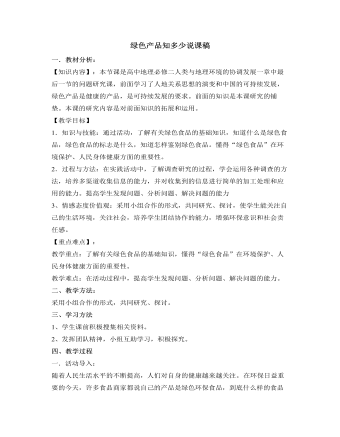
人教版高中地理必修2绿色产品知多少说课稿
各小组派代表汇报。4、教师提出问题组织学生讨论:⑴要想了解更多的绿色食品,了解绿色食品的销售情况,我们应该怎么做?⑵要想了解广大消费者对绿色食品的态度,食用绿色食品的意义,是否懂得辨认绿色食品,以及什么样的人群对此知识最缺乏等,我们应该怎么做?组织学生汇报交流。5、做个“绿色食品”广告设计师。为你喜欢的绿色食品设计广告语,每组推荐一个。6、让学生了解绿色食品认证程序。7、绿色食品打“假”队员在行动。8、向学生介绍生态绿色食品基地。三、活动总结:通过研究、探讨,了解学生对绿色食品的态度。提问:民以食为天,吃,是一个大问题,如果你的爸爸妈妈让你到超市买牛奶、方便面等,你会选择什么样的食品?为什么?希望通过今天的学习,同学们能够做到绿色消费,也希望你们向自己的家人、向周围的了解学生对“无公害食品”、“有机食品”与“绿色食品”的认识。

人教版高中地理必修2煤城焦作出路何在说课稿
分析过焦作市的地理概况和产业优势后,就需要针对由于资源枯竭所带来的问题提出合理化的建议。既然是谈经济转型,就应该将话题的范围明确在这一领域内。通过材料3的相关内容,我们了解到焦作市需要在产业结构调整、培育新的优势产业、增强综合竞争力等三个整改方针上下功夫。因而引导学生针对优势与不足提出建议,以三个整改方针为基准,衡量建议的可行性是锻炼学生解决此类问题的有效途径。在此我将教会学生的是解决问题方法而非案例的内容,正所谓“授之以鱼,不如授之以渔”。接下来针对学生的建议和教材资料分析所罗列的10点整改思路,由学生自由发言提出看法,通过教师的指导和学生的讨论,进而确定经济转型建议的具体方案。最后注意将建议与产业优势相对照,看建议是否都是围绕着产业优势而提出的,这样做会加深学生的印象,通过建议和优势的对应关系,将不难找出此类问题的解题思路。
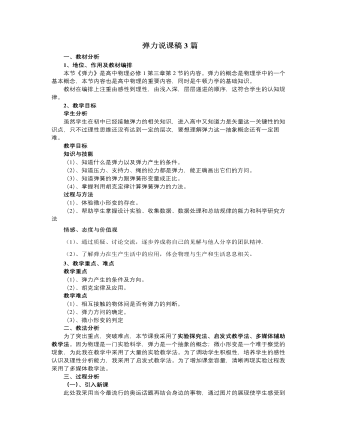
人教版新课标高中物理必修1弹力说课稿3篇
基于以上分析,为使本堂课围绕重点、突破难点,同时让学生在课堂教学中能力得到提高,我设计如下教学过程。(一)创设情景认识形变由同学们已有的形变知识入手,引入新课。教师演示:①弹簧的压缩形变;②弹簧的拉伸形变③视频播放:竹竿形变、钢丝的扭转形变。得出形变的概念及各类形变。[设计意图:我从生活情景中引入新课,是为了激发学生的好奇心,为学生学习重点和难点内容作铺垫。]设问:摩天大楼在风的吹拂下会不会摆动,发生形变吗?演示微小形变放大实验:由于这种形变不容易观察,会使学生产生疑问:到底有没有发生形变?解决的办法是微小形变的演示实验。为什么光点会往下移?让学生带着问题思考后得出结论:是由于桌面发生了形变,但是形变不明显。为后面解决压力和支持力都是弹力做好铺垫。[设计意图:使学生知道“放大”是一种科学探究的方法。]
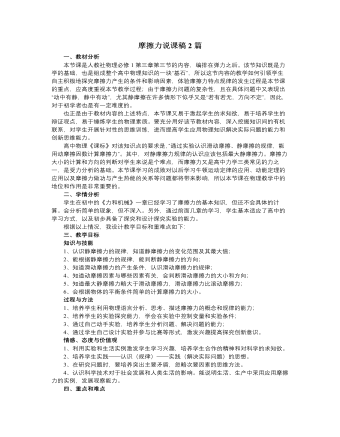
人教版新课标高中物理必修1摩擦力说课稿2篇
本节课是人教社物理必修1第三章第三节的内容,编排在弹力之后。该节知识既是力学的基础,也是组成整个高中物理知识的一块“基石”,所以这节内容的教学如何引领学生自主积极地探究摩擦力产生的条件和影响因素,体验摩擦力特点规律的发生过程是本节课的重点,应高度重视本节教学过程;由于摩擦力问题的复杂性,且在具体问题中又表现出“动中有静,静中有动”,尤其静摩擦在许多情形下似乎又是“若有若无,方向不定”,因此,对于初学者也是有一定难度的。也正是由于教材内容的上述特点,本节课又易于激起学生的求知欲,易于培养学生的辩证观点,易于锤炼学生的物理素质。要充分用好该节教材内容,深入挖掘知识间的有机联系,对学生开展针对性的思维训练,进而提高学生应用物理知识解决实际问题的能力和创新思维能力。高中物理《课标》对该知识点的要求是,“通过实验认识滑动摩擦、静摩擦的规律,能用动摩擦因数计算摩擦力”。其中,对静摩擦力规律的认识应该包括最大静摩擦力。
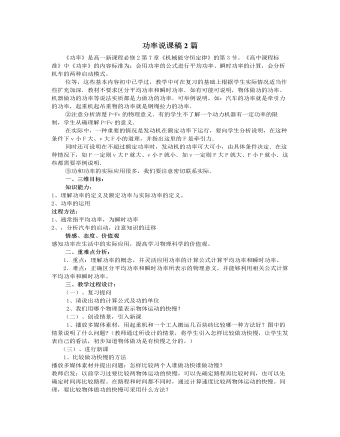
人教版新课标高中物理必修2功率说课稿2篇
(一)、复习提问1、请说出功的计算公式及功的单位2、我们用哪个物理量表示物体运动的快慢?(二)、创设情景,引入新课1、播放多媒体素材,用起重机和一个工人搬运几百块砖比较哪一种方法好?图中的情景说明了什么问题?(教师通过所设计的情景,将学生引入怎样比较做功快慢,让学生发表自己的看法,初步知道物体做功是有快慢之分的。)(三)、进行新课1、比较做功快慢的方法播放多媒体素材并提出问题:怎样比较两个人谁做功快谁做功慢?教师启发:以前学习过要比较两物体运动的快慢,可以先确定路程再比较时间,也可以先确定时间再比较路程。在路程和时间都不同时,通过计算速度比较两物体运动的快慢。同理,要比较物体做功的快慢可采用什么方法?
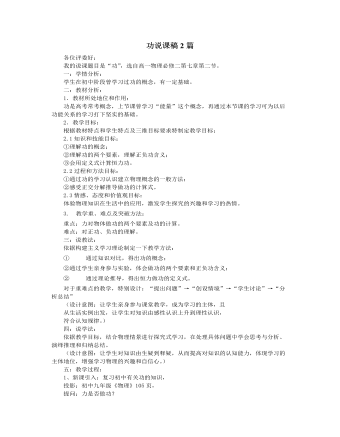
人教版新课标高中物理必修2功说课稿2篇
探究一:高中阶段功的含义是什么?投影:初中九年级《物理》105页学生思考:①图中物体的势能、动能分别如何变化?②物体能量的变化和做功是否存在关系?学生:分组讨论,得出结论:如果物体的能量发生变化时,说明有力对物体做了功。教师:进行点评和小结(设计意图:对初中知识深化理论认识,并为以后功能关系的教学作准备)探究二:力对物体做功的两个要素是什么?情景再现:找体重相对悬殊的两位同学,①A同学试图抱起B同学,但没成功。②B同学抱起A同学在教室内匀速走动。学生思考:在①中,A是否对B做功?在②中,B是否对A做功?学生:分析得出做功的两要素:物体受到力的作用,并且在力的方向上发生位移.教师:让学生分别例举生活中力对物体做功和不做功的例子,(设计意图:让学生亲身参与课堂实验,烘托课堂气氛,相互协作增进同学情谊)探究三:如果物体的位移不再力的方向上,那么力是否还对物体做功?
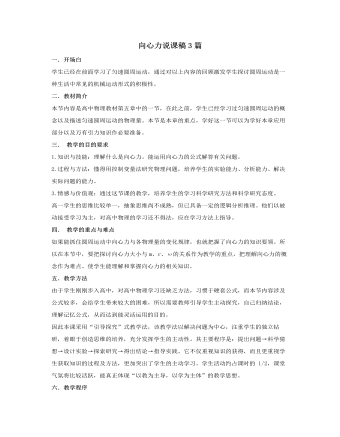
人教版新课标高中物理必修2向心力说课稿3篇
通过这个示例呢,我们可以得到解决向心力问题的一般的步骤,确定对象,找出轨迹,找出圆心,然后进行受力分析,让同学们参考这样的步骤,逐步的解决圆周运动的问题,对于变速圆周运动,我通过链球运动进行引入,这里是一个链球运动的视频,在同学们观看视频之前,我给同学们提出问题,链球收到绳子的拉力,做的是匀速圆周运动吗? 然后再课堂上我们再做一个小实验, 我们可以通过改变拉线的方式来调节小球的速度大小吗? 那么对小球,做加速圆周运动,进行受力分析,我们可以看到,小球做加速运动时,他所受到的力,并不是严格通过轨迹的圆心,在进行分析的时候,特别强调,小桶所受力的切线方向分力,和法线方向分力,切线方向分力,改变小球运动速度大小,法线方向分力,改变了小球运动的方向,法线方向的分力,在这里就是向心力,产生了向心加速度,通过这样一个例子进行分析,同学们是比较容易理解的,
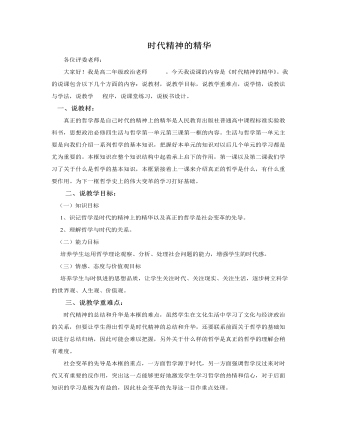
人教版高中政治必修4时代的精神的精华说课稿
(二)能力目标培养学生运用哲学理论观察、分析、处理社会问题的能力,增强学生的时代感。(三)情感、态度与价值观目标培养学生与时俱进的思想品质,让学生关注时代、关注现实、关注生活,逐步树立科学的世界观、人生观、价值观。三、说教学重难点:时代精神的总结和升华是本框的难点,虽然学生在文化生活中学习了文化与经济政治的关系,但要让学生得出哲学是时代精神的总结和升华,还要联系前面关于哲学的基础知识进行总结归纳,因此可能会难以把握,另外关于什么样的哲学是真正的哲学的理解会稍有难度。社会变革的先导是本框的重点,一方面哲学源于时代,另一方面强调哲学反过来对时代又有重要的反作用,突出这一点能够更好地激发学生学习哲学的热情和信心,对于后面知识的学习是极为有益的,因此社会变革的先导这一目作重点处理。
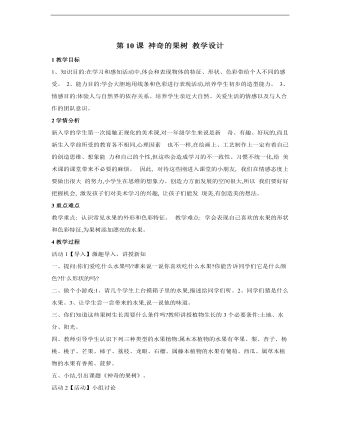
小学美术桂美版一年级上册《第10课神奇的果树》教学设计说课稿
2学情分析 新入学的学生第一次接触正规化的美术课,对一年级学生来说是新 奇、有趣、好玩的,而且新生入学前所受的教育各不相同,心理因素 也不一样,在绘画上、工艺制作上一定有着自己的创造思维、想象能 力和自己的个性,但这些会造成学习的不一致性、习惯不统一化,给 美术课的课堂带来不必要的麻烦。因此, 对待这些刚进入课堂的小朋友, 我们在情感态度上要做出很大 的努力,小学生在思维的想象力、创造力方面发展的空间很大,所以 我们要好好把握机会, 激发孩子们对美术学习的兴趣,让孩子们能发 现美,有创造美的想法。
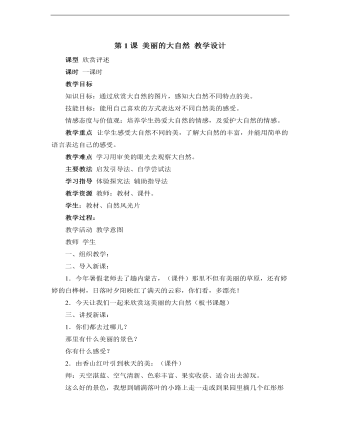
小学美术桂美版一年级上册《第1课美丽的大自然》教学设计说课稿
教学目标 知识目标:通过欣赏大自然的图片,感知大自然不同特点的美。 技能目标:能用自己喜欢的方式表达对不同自然美的感受。 情感态度与价值观:培养学生热爱大自然的情感,及爱护大自然的情感。 教学重点让学生感受大自然不同的美,了解大自然的丰富,并能用简单的语言表达自己的感受。 教学难点学习用审美的眼光去观察大自然。 主要教法启发引导法、自学尝试法 学习指导体验探究法辅助指导法 教学资源教师:教材、课件。 学生:教材、自然风光片 教学过程: 教学活动教学意图 教师学生
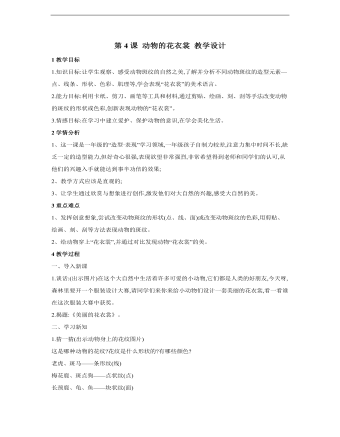
小学美术桂美版一年级上册《第4课动物的花衣裳》教学设计说课稿
2学情分析 1、这一课是一年级的“造型·表现”学习领域,一年级孩子自制力较差,注意力集中时间不长,缺乏一定的造型能力,但好奇心很强,表现欲望非常强烈,非常希望得到老师和同学们的认可,从他们的兴趣入手就能达到事半功倍的效果;2、教学方式应该是直观的;3、让学生通过欣赏与想象进行创作,激发他们对大自然的兴趣,感受大自然的美。

小学美术桂美版一年级上册《第6课送给老师的爱》教学设计说课稿
教学过程:一、组织教学,导入学习1.观察导入,激发兴趣(教具出示)2.教师和学生一起做猜节日的游戏,激发学生的兴趣。 每年的9月10日都是教师们最开心的日子,也是学生们表达对老师尊敬的日子,中国自古以来便有尊师重教的传统,《教师法》 第四条规定全社会应当尊重教师。
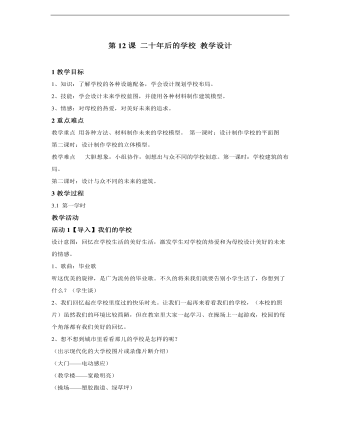
小学美术人教版六年级下册《第12课二十年后的学校》教学设计
2重点难点教学重点用各种方法、材料制作未来的学校模型。第一课时:设计制作学校的平面图第二课时:设计制作学校的立体模型。教学难点大胆想象,小组协作,创想出与众不同的学校创意。第一课时:学校建筑的布局。第二课时:设计与众不同的未来的建筑。3教学过程3.1 第一学时
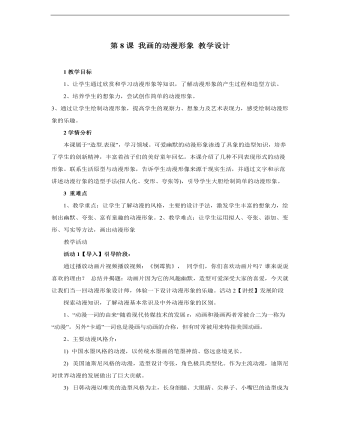
小学美术人教版四年级下册《第8课我画的动漫形象3》教学设计说课稿
2学情分析本课属于“造型.表现”,学习领域。可爱幽默的动漫形象渗透了具象的造型知识,培养了学生的创新精神,丰富着孩子们的美好童年回忆。本课介绍了几种不同表现形式的动漫形象。联系生活原型与动漫形象,告诉学生动漫形像来源于现实生活,并通过文字和示范讲述动漫行象的造型手法(拟人化、变形、夸张等),引导学生大胆绘制简单的动漫形象。3 重难点1、教学重点:让学生了解动漫的风格,主要的设计手法,激发学生丰富的想象力,绘制出幽默、夸张、富有童趣的动漫形象。2、教学难点:让学生运用拟人、夸张、添加、变形、写实等方法,画出动漫形象

小学美术人教版四年级下册《第8课我画的动漫形象4》教学设计说课稿
2学情分析可以说动漫卡通一直伴随着孩子们的成长,每个孩子都十分喜爱看动漫卡通,尤其是现在的儿童更是在动漫卡通世界里成长的一代,所以学生对动漫卡通形象并不陌生。本课通过大量学生喜欢的动漫卡通形象的欣赏,掌握动漫卡通画形象的创作表现方法。3重点难点教学重点:感受动漫卡通形象灵动多变的造型之美,并体会创作的乐趣。教学难点:利用学到的知识,进行动漫卡通形象表现。
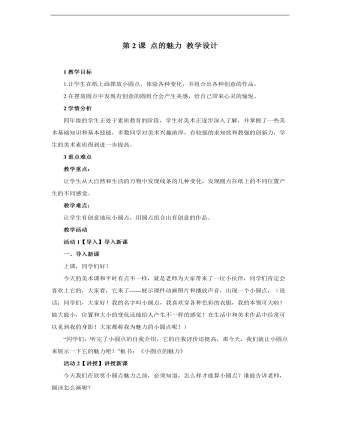
小学美术人教版四年级下册《第2课点的魅力1》教学设计说课稿
2学情分析四年级的学生正处于素质教育的阶段,学生对美术正逐步深入了解,并掌握了一些美术基础知识和基本技能,多数同学对美术兴趣浓厚,有较强的求知欲和教强的创新力,学生的美术素质得到进一步提高。3重点难点教学重点:让学生从大自然和生活的万物中发现线条的几种变化,发现圆点在纸上的不同位置产生的不同感觉。

小学美术人教版二年级上册《第3课装饰自己的名字》教学设计说课稿
2学情分析二年级学生活泼可爱,思维独特,喜欢按照自己的想法自由地表现画面。好奇心强,爱表现自己,但动手能力较差,只能用简单的工具和绘画材料来稚拙地表现自己的想法。本课以学生亲切、熟悉的名字为题材,更好的激发学生的表现欲望和独创思维,让学生能够自信、大胆、自由地通过美术形式表达想法与感情。3重点难点重点:设计具有自己特色的名字。难点:能对名字的字形进行分析,巧妙地运用笔画特征进行想象设计。教学活动
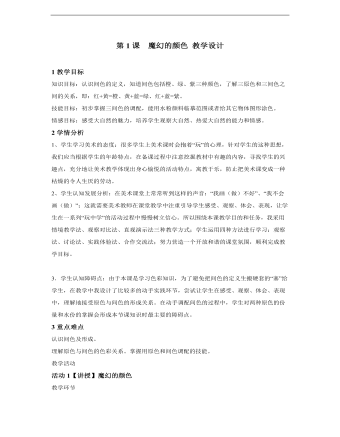
小学美术人教版三年级上册《第1课魔幻的颜色》教学设计说课稿
2学情分析1、学生学习美术的态度:很多学生上美术课时会抱着“玩”的心理,针对学生的这种思想,我们应当根据学生的年龄特点,在备课过程中注意挖掘教材中有趣的内容,寻找学生的兴趣点,充分地让美术教学体现出身心愉悦的活动特点,寓教于乐,防止把美术课变成一种枯燥的令人生厌的劳动。2、学生认知发展分析:在美术课堂上常常听到这样的声音:“我画(做)不好”、“我不会画(做)”;这就需要美术教师在课堂教学中注重引导学生感受、观察、体会、表现,让学生在一系列“玩中学”的活动过程中慢慢树立信心。所以围绕本课教学目的和任务,我采用情境教学法、观察对比法、直观演示法三种教学方式;学生运用四种方法进行学习:观察法、讨论法、实践体验法、合作交流法;努力营造一个开放和谐的课堂氛围,顺利完成教学目标。
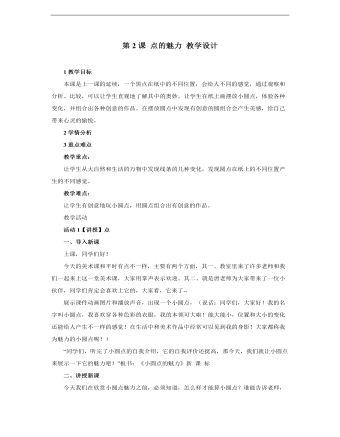
小学美术人教版四年级下册《第2课点的魅力2》教学设计说课稿
一、导入新课上课,同学们好!今天的美术课和平时有点不一样,主要有两个方面,其一、教室里来了许多老师和我们一起来上这一堂美术课,大家用掌声表示欢迎。其二、就是唐老师为大家带来了一位小伙伴,同学们肯定会喜欢上它的,大家看,它来了--展示课件动画图片和播放声音,出现一个小圆点,(说话:同学们,大家好!我的名字叫小圆点,我喜欢穿各种色彩的衣服,我的本领可大啦!能大能小,位置和大小的变化还能给人产生不一样的感觉!在生活中和美术作品中经常可以见到我的身影!大家都称我为魅力的小圆点呢!)





















